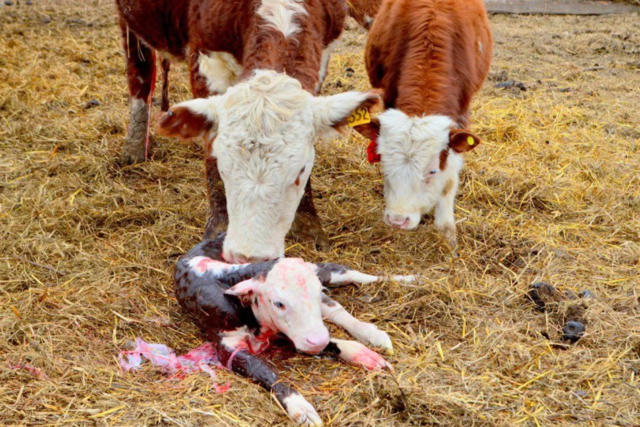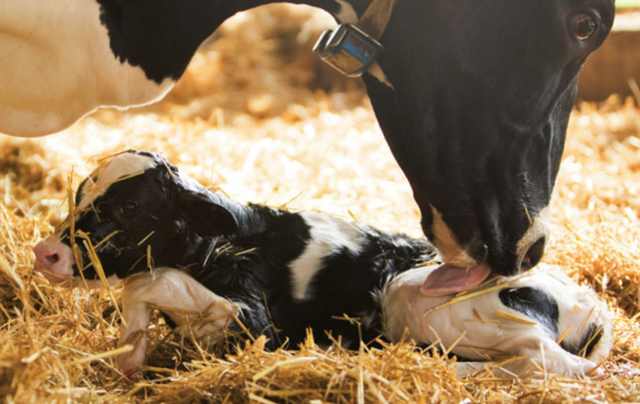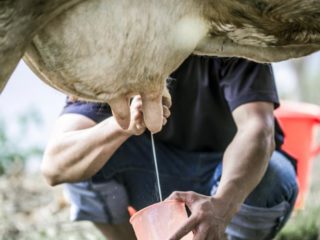Content
The gestation period has a fairly wide range, however, if the cow calves earlier than the date of up to 240 days, we are talking about premature calving. An early birth can result in both a viable calf and a weak or dead calf.
Can a cow calve early?
A cow's gestation period lasts 285 days on average. The appearance of a calf earlier than the established date, but not earlier than 240 days of gestation, is not a pathology. The period of bearing the fetus largely depends on the conditions of keeping and feeding, the early maturity of the animal, the sex and weight of the fetus.
If signs of labor in a cow appear earlier than on the 240th day of pregnancy, then the birth is considered premature and requires immediate measures, the intervention of a veterinarian.
Causes of premature calving in a cow
Causes of premature calving:
- injuries to the abdominal wall resulting from a fall, impact, sudden movements or jumping;
- careless rectal or vaginal examination;
- feeding the animal poor-quality, moldy, frozen food;
- feeding a pregnant cow with too cold water at a temperature below + 10-12 ° С;
- non-observance of the temperature regime in the room;
- the use of drugs that cause uterine contraction;
- infectious diseases;
- stress or severe fright of the animal.
Also, premature birth is often observed with multiple pregnancies and when carrying a large fetus.
Harbingers of early calving in a cow
Harbingers of early calving, as a rule, are absent. Premature contractions in premature labor in cows may appear 3-4 weeks before labor begins. Attempts and contractions can last from several hours to 3 days. In this case, the pelvic ligaments of the animal do not relax, and the cervix does not open.
Premature labor usually starts unexpectedly and quickly. Contractions during early pathological childbirth are very painful and frequent. Prolonged contractions are exhausting, depriving the animal of strength and can result in abortion.
Signs of premature calving:
- change in behavior, anxiety of the animal;
- refusal of feed;
- increased body temperature;
- increased heart rate and breathing;
- contraction of the muscles of the peritoneum;
- sometimes there is a slight dilatation of the cervix;
- with rectal examination, successive contractions and relaxation of the uterus are noted.
To reduce the intensity of pushing, it is necessary to place the animal in a darkened warm room with a sloping floor. You can also make a careful short posting of the animal without sudden movements. On the sacrum and lower back of a pregnant animal, you need to put a warm compress - bags of warm sand, you can also make hot poultices from hay or straw.
If labor does not stop, the veterinary specialist conducts sacral epidural anesthesia between the last sacral and first caudal vertebrae (or between the first and second caudal vertebrae), injects 1% novocaine solution at a dosage of 10-20 ml. You can also use intramuscular injection of the drug "Hanegif", as a relaxant of the uterus, in a dosage of 10 ml.
What to do if a cow calves ahead of time
If signs of early calving appear, namely changes in the physiological state and behavior of the animal, you should first seek the help of a veterinarian. It is necessary to provide special conditions for a favorable calving or further course of pregnancy (if signs appeared in the early stages of pregnancy).
Calving prematurely provokes the birth of a weak calf with little chance of survival. If there are no pathological changes in the body of a premature calf, there is a sucking reflex, the entire surface of the body is covered with hair, then there is a chance to leave the calf. The newborn animal should be dried, wrapped in a warm blanket, covered with heating pads and placed in a warm room with a temperature of at least + 25-30 ° C. Often in animals after calving prematurely or abortions with expulsion of the premature birth, there is a lack of colostrum. In this case, the calf urgently needs to look for a wet nurse or transfer to artificial feeding.
Why is it dangerous to give birth to a cow ahead of time?
Calving before the minimum time is considered a pathology. The result of premature birth can be both the birth of a premature weak calf, and the death of the fetus from asphyxia, followed by maceration (liquefaction of the soft tissues of the fetus, swelling), and after mummification (drying and calcification of the fetus) and putrefactive decomposition (emphysematous fetus).
With multiple pregnancies, premature contractions and attempts ahead of time can lead to the expulsion of one fetus - a miscarriage or premature birth. With an incomplete abortion, the second fetus often continues to develop normally in the womb and is born on time. In this case, careful monitoring of the course of pregnancy and the development of the second fetus is required, since often with pathological childbirth, the placental connection is disrupted and pregnancy ends in abortion.
Pregnant animals, especially heifers, need daily supervision. If the first heifer calves ahead of time, it is necessary to find out the reason for this phenomenon, since often the subsequent periods of pregnancy in such cows also end in premature birth. In order to exclude the cause of premature birth 60 days before the expected date of calving, it is necessary to isolate pregnant animals in a separate room, to ensure proper feeding and care. To eliminate the likelihood of injury, it is necessary to keep the animal on a leash, not forgetting about daily exercise for 2-3 hours a day.
Conclusion
If the cow calves ahead of time, the owner must take a set of measures to nurture the premature calf and monitor the health of his mother. Early calving in cows occurs for various reasons, most often as a result of injury, improper maintenance or feeding of poor quality feed.











How to find out at home whether a cow has a multiple pregnancy or not?